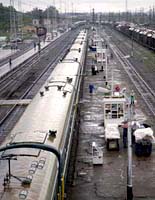 In fact, by jet from Moscow, it takes about eight hours to reach Vladivostok on the Pacific Oceancoast. If you were to take the trip on the Trans-Siberian Railroad, you can count on your journey taking at least 4 days minimum.
In fact, by jet from Moscow, it takes about eight hours to reach Vladivostok on the Pacific Oceancoast. If you were to take the trip on the Trans-Siberian Railroad, you can count on your journey taking at least 4 days minimum. Russia has over 1,000 major cities, 16 of which have a metro population of more than one million; the most populated cities are Moscow, St. Petersburg, Novosibirsk, Yekaterinburg and Nizhny Novgorod.
Moscow, the capital, with over 12 million (metro) residents, is the country's major economic and political center - the seat of the President, the government and the State Duma.
The Russian landmass west of the Ural Mountains (shown above in a lighter shade of grey) is referred to as European Russia by most educational atlases and geography experts. It is not a separate country, but rather called that because of its political, cultural and geographical blendings with Europe.
A Brief History of Russia
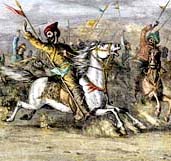 Historically, Russia was occupied by Mongols, and the likes, for centuries. Early Russian ancestors belonged to Slavic tribes, and by the mid-9th century vikings arrived. The vikings moved across the vast landscape, utilizing the many waterways, and maintained trade along the way.
Historically, Russia was occupied by Mongols, and the likes, for centuries. Early Russian ancestors belonged to Slavic tribes, and by the mid-9th century vikings arrived. The vikings moved across the vast landscape, utilizing the many waterways, and maintained trade along the way. Eventually, the Norse peoples merged with the Slavic population, absorbing Greek Christian influences as well, and then, in the mid-1200s the Mongols arrived.
The impact of the Mongol invasion, at best, was uneven - older cities never completely recovered from the destruction, while the new cities of Moscow, Tver and Nizhny Novgorod began to fight for power amidst the Mongol-dominated land.
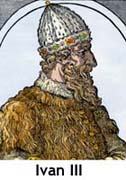 The Mongols began to falter by the middle of the 14th century, and, upon their eventual collapse, Moscow's leadership began to expand outward. The influence of the Mongols in terms of military tactics and transportation remained with the Russian peoples, and in the 15th century Ivan III (Ivan the Great) organized the foundation for a Russian national state.
The Mongols began to falter by the middle of the 14th century, and, upon their eventual collapse, Moscow's leadership began to expand outward. The influence of the Mongols in terms of military tactics and transportation remained with the Russian peoples, and in the 15th century Ivan III (Ivan the Great) organized the foundation for a Russian national state. Ivan IV emerged in 1547 as a powerful, autocratic ruler - giving himself the title of "Tsar" - he was known for his ruthlessness, and strengthened the position of the monarch to an unparalleled degree.Cohorts of Ivan IV executed a series of bloody battles, and, coupled with additional epidemics and poor harvests plaguing the country, Russia became severely weakened in the late 1500s.
Following the death of Ivan IV, troubled times prevailed across Russia, as extremely cold summers led to a famine and civil wars broke out across the country. Further adding to their misfortune, on September 21, 1610 Poland invaded Moscow, savagely repressing riots, and setting the city on fire.
Romanov Influence
A volunteer army, led by Kuzma Minin and Dmitry Pozharsky, pushed out the Polish forces in 1612, and the following year Michael Romanov was elected to the throne (thus beginning the 300 year control of the Romanov family).
Czar Peter I brought autocracy into Russia, and really began the transformation of the Russian Empire. After the reign of Queen Catherine II, it emerged as an influential and powerful Europeanforce.
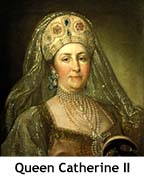 Under Catherine the Great, Russia's political control was extended to cover the Polish - Lithuanian Commonwealth, and a war was waged that completely decayed the Ottoman Empire, thus advancing Russia's southern boundary to the Black Sea.
Under Catherine the Great, Russia's political control was extended to cover the Polish - Lithuanian Commonwealth, and a war was waged that completely decayed the Ottoman Empire, thus advancing Russia's southern boundary to the Black Sea. In the early 19th century, Nicholas I succeeded the throne, only to be confronted by an uprising; conflicting views from Peter the Great's order of action to westernize Russia garnered widely varied opinions on whether to imitate Europe or return to the traditions of the past.
Despite the civil dispute, Russia was ultimately pressured into the involvement of European affairs as part of the "Holy Alliance."
After the death of Tsar Nicholas, Russia became involved in a series of wars, including the Crimean War (1853) and the Russo-Turkish War (1877).
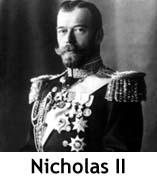 In the midst of the Industrial Revolution, one that significantly influenced the country, Nicholas II gained control of Russia, and opposition forces began to organize into competing parties.
In the midst of the Industrial Revolution, one that significantly influenced the country, Nicholas II gained control of Russia, and opposition forces began to organize into competing parties. As World War I reared its ugly head in the early 20th century, Russia, bound by treaty, entered the war at the defense of Serbia. The impact of the war crippled Russia, as food and fuel grew short in supply, casualties amassed, and inflation grew steadily.In 1903, Vladimir Lenin and Alexander Bogdanov founded the Bolsheviks (a mass organization of workers who believed in the principle of democratic centralism) and under the leadership of Lenin, the Bolsheviks sought to overthrow the Tsar.
By early 1917, Russia was nearing a total collapse, and on March 15, Nicholas II abdicated the throne. Desperately wanting to exile to the United Kingdom, Nicholas II and his family were instead forced to evacuate to Tobolsk in the Ural Mountains.
Sadly, the Romanov family - Nicholas II, his wife and their five children (including Anastasia) - were executed on July 17, 1918 by the command of Bolshevik officer Yakov Yurovsky.
Soviet Ruling
Under Soviet ruling, the Marxist theory formed the basis of life, as the government promoted atheism and materialism; in addition, the patriarchal domination of family became severely weakened. Women flooded the labor market, and young girls were encouraged to maintain their education and pursue careers.
Joseph Stalin established almost complete control of the Russian society by 1929, and following Lenin's death attempted to secure his status.
The first of a number of plans known as the Five-Year Plan, proposed by Stalin, set Russia up to be the first ever government to control all economic activity. In the span of just a few years, nearly one million peasants were forced off their land, and Russian cities became over-saturated with industrial workers.
During World War II, the Soviet Union aligned with the Allied Powers, and, although victorious, in the war's aftermath the Soviet economy struggled to regain its composure.
Further adding to the troubles, the Cold War emerged during the summer of 1945, after a conflict between Stalin and U.S.President Harry Truman over the future of eastern Europe.
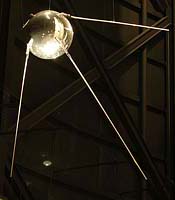 The USSR pioneered the Space Age with the launch of the world's first artificial satellite, Sputnik 1, and on April 12, 1961, Yuri Gagarin became the first human to orbit Earth.
The USSR pioneered the Space Age with the launch of the world's first artificial satellite, Sputnik 1, and on April 12, 1961, Yuri Gagarin became the first human to orbit Earth. Despite showcasing some of the most significant technological achievements of the 20th century, in 1991 the USSR dissolved, and when that union ended, Russia itself and its former republics all became separate countries.
The first direct presidential election in Russian history was held in June 1991, with Boris Yeltsin being the victor; in addition, Russia's economy shifted following the breakup of the USSR, causing a major crisis.
Today, this super-sized country is led by President Vladimir V. Putin, as he attempts to manage this massive slice of real estate, as well as maintain positive relationships with bothAsian, European and Western powers - and what a job he has!
No comments:
Post a Comment